Evaluating the Chances of Implementing the “Fit for 55” Green Transition Package in the V4 Countries
Abstract
1. Introduction
2. European Nations’ Decade-Long National Energy and Climate Strategies for 2021–2030
- Decreasing greenhouse gas (GHG) emissions by at least 20% relative to the 1990 levels;
- Raising the proportion of renewable energy sources (RESs) in final energy consumption to 20%;
- Progress toward a 20% enhancement in energy efficiency (from 2005 levels).
- Decreasing greenhouse gas (GHG) emissions by at least 55% relative to 1990 levels;
- Raising the proportion of renewable energy sources (RESs) in final energy consumption to 32%;
- Progress toward a 32.5% enhancement in energy efficiency (from 2005 levels).
3. Materials and Methods
4. Results and Discussion
4.1. Czech Republic
4.2. Hungary
4.3. Poland
4.4. Slovakia
5. Conclusions
- The Czech Republic generates too much energy from fossil fuels, and its plans to increase the share of renewable energy are small (but still the largest among the V4 countries). Since these goals are low-set, they should be easy to achieve. The only problem may be reduction in the FEC by 2030.
- Hungary’s energy mix is not bad, but the country has not set ambitious targets in its climate strategy for 2030; e.g., the targets for the PEC and the FEC for 2030 are worse than those for 2020. As far as Hungary wants to develop its nuclear energy, it may have a problem with achievement of an appropriate share of renewable energy.
- Poland is heavily dependent on fossil fuels, which puts it in the worst situation among the V4 countries. The PEC and the FEC in Poland are growing instead of decreasing, and the share of renewable energy in the energy mix seems impossible to achieve by 2030. Huge amounts of greenhouse gases emitted by Poland could hamper the EU’s 55% greenhouse-gas reduction target in 2030.
- Slovakia has 92% of its primary energy produced via nuclear and renewable sources, and it is in the best situation among the V4 countries. The country has a plan to phase out coal mining and coal-fired electricity generation by 2023. The 2030 climate targets negotiated by Slovakia are very cautious and are considered unambitious. Projections confirm that all targets should be achieved by 2030.
Author Contributions
Funding
Data Availability Statement
Conflicts of Interest
References
- Marusiak, J.; Gyarfasova, O.; Krno, C.; Mészáros, A.; Štiblar, P.; Suska, P.; Veselý, C.; Wołek, D. Internal Cohesion of the Visegrad Group; Institute of Political Science, Slovak Academy of Sciences - VEDA, Publishing House of the Slovak Academy of Sciences: Bratislava, Slovakia, 2013; ISBN 978-80-224-1329-9. [Google Scholar]
- Kořan, M. The Visegrad Group on the Threshold of Its Third Decade: A Central European Hub? In Regional and International Relations of Central Europe; Palgrave Macmillan: London, UK, 2012; pp. 201–218. ISBN 978-1-349-34805-3. [Google Scholar]
- Sulich, A.; Sołoducho-Pelc, L. Renewable Energy Producers’ Strategies in the Visegrád Group Countries. Energies 2021, 14, 3048. [Google Scholar] [CrossRef]
- Wach, K.; Głodowska, A.; Maciejewski, M.; Sieja, M. Europeanization Processes of the EU Energy Policy in Visegrad Countries in the Years 2005–2018. Energies 2021, 14, 1802. [Google Scholar] [CrossRef]
- Schmidt, A. Friends Forever? The Role of the Visegrad Group and European Integration. Politics Cent. Eur. 2016, 12, 113–140. [Google Scholar] [CrossRef]
- Kazharski, A. The End of ‘Central Europe’? The Rise of the Radical Right and the Contestation of Identities in Slovakia and the Visegrad Four. Geopolitics 2018, 23, 754–780. [Google Scholar] [CrossRef]
- Strážay, T. Towards a Sustainable Visegrad: Some Reflections on the Future Role of Central Europe in the EU. In Understanding Central Europe; Routledge: New York, NY, USA, 2017; pp. 115–118. ISBN 1-315-15773-X. [Google Scholar]
- Deák, A.; Weiner, C. Hungary: Leveraging Political Influence. In The Russian Economic Grip on Central and Eastern Europe; Routledge Contemporary Russia and Eastern Europe Series; Routledge: Abingdon, NY, USA, 2019; pp. 136–150. [Google Scholar]
- Ruszel, M. The Significance of the Baltic Sea Region for Natural Gas Supplies to the V4 Countries. Energy Policy 2020, 146, 111786. [Google Scholar] [CrossRef]
- Rokicki, T.; Perkowska, A. Changes in Energy Supplies in the Countries of the Visegrad Group. Sustainability 2020, 12, 7916. [Google Scholar] [CrossRef]
- Haitas, D. Aspects of Hungary-Russia Energy Relations in the Context of European Union Law. Jura A Pecsi Tudegy. All.-Es Jogtud. Karanak Tud. Lapja 2018, 2, 368. [Google Scholar]
- Szabo, J.; Fabok, M. Infrastructures and State-Building: Comparing the Energy Politics of the European Commission with the Governments of Hungary and Poland. Energy Policy 2020, 138, 111253. [Google Scholar] [CrossRef]
- Siddi, M. Theorising Conflict and Cooperation in EU-Russia Energy Relations: Ideas, Identities and Material Factors in the Nord Stream 2 Debate. East Eur. Politics 2020, 36, 544–563. [Google Scholar] [CrossRef]
- Tichý, L.; Dubský, Z. Russian Energy Discourse on the V4 Countries. Energy Policy 2020, 137, 111128. [Google Scholar] [CrossRef]
- Walsch, C. Visegrad Four in the European Union. An Efficient Regional Cooperation Scheme? Int. Issues Slovak Foreign Policy Aff. 2014, 23, 25–41. [Google Scholar]
- European Commission 2020 Climate & Energy Package. Available online: https://ec.europa.eu/clima/policies/strategies/2020_en (accessed on 17 January 2023).
- European Commission 2030 Climate Target Plan. Available online: https://ec.europa.eu/clima/policies/eu-climate-action/2030_ctp_en (accessed on 17 January 2023).
- Ghiani, E.; Galici, M.; Mureddu, M.; Pilo, F. Impact on Electricity Consumption and Market Pricing of Energy and Ancillary Services during Pandemic of COVID-19 in Italy. Energies 2020, 13, 3357. [Google Scholar] [CrossRef]
- Nagaj, R.; Korpysa, J. Impact of COVID-19 on the Level of Energy Poverty in Poland. Energies 2020, 13, 4977. [Google Scholar] [CrossRef]
- Chapman, A.; Tsuji, T. Impacts of COVID-19 on a Transitioning Energy System, Society, and International Cooperation. Sustainability 2020, 12, 8232. [Google Scholar] [CrossRef]
- Polemis, M.; Soursou, S. Assessing the Impact of the COVID-19 Pandemic on the Greek Energy Firms: An Event Study Analysis. Energy Res. Lett. 2020, 1, 17238. [Google Scholar] [CrossRef]
- Bahmanyar, A.; Estebsari, A.; Ernst, D. The Impact of Different COVID-19 Containment Measures on Electricity Consumption in Europe. Energy Res. Soc. Sci. 2020, 68, 101683. [Google Scholar] [CrossRef] [PubMed]
- Siksnelyte-Butkiene, I. Combating Energy Poverty in the Face of the COVID-19 Pandemic and the Global Economic Uncertainty. Energies 2022, 15, 3649. [Google Scholar] [CrossRef]
- Kristóf, T. Sovereign Default Forecasting in the Era of the COVID-19 Crisis. JRFM 2021, 14, 494. [Google Scholar] [CrossRef]
- Klenert, D.; Funke, F.; Mattauch, L.; O’Callaghan, B. Five Lessons from COVID-19 for Advancing Climate Change Mitigation. Environ. Resour. Econ. 2020, 76, 751–778. [Google Scholar] [CrossRef]
- Chernysh, Y.; Roubík, H. International Collaboration in the Field of Environmental Protection: Trend Analysis and COVID-19 Implications. Sustainability 2020, 12, 10384. [Google Scholar] [CrossRef]
- Siksnelyte-Butkiene, I.; Karpavicius, T.; Streimikiene, D.; Balezentis, T. The Achievements of Climate Change and Energy Policy in the European Union. Energies 2022, 15, 5128. [Google Scholar] [CrossRef]
- Brożyna, J.; Strielkowski, W.; Fomina, A.; Nikitina, N. Renewable Energy and EU 2020 Target for Energy Efficiency in the Czech Republic and Slovakia. Energies 2020, 13, 965. [Google Scholar] [CrossRef]
- Conte, A.; Lecca, P.; Sakkas, S.; Salotti, S. The Territorial Economic Impact of COVID-19 in the EU. A RHOMOLO Analysis; Joint Research Centre (Seville site): Sevilla, Spain, 2020. [Google Scholar]
- Oncioiu, I.; Duca, I.; Postole, M.A.; Georgescu (Crețan), G.C.; Gherghina, R.; Grecu, R.-A. Transforming the COVID-19 Threat into an Opportunity: The Pandemic as a Stage to the Sustainable Economy. Sustainability 2021, 13, 2088. [Google Scholar] [CrossRef]
- Pinilla, J.; Barber, P.; Vallejo-Torres, L.; Rodríguez-Mireles, S.; López-Valcárcel, B.G.; Serra-Majem, L. The Economic Impact of the SARS-CoV-2 (COVID-19) Pandemic in Spain. Int. J. Environ. Res. Public Health 2021, 18, 4708. [Google Scholar] [CrossRef]
- Lahcen, B.; Brusselaers, J.; Vrancken, K.; Dams, Y.; Da Silva Paes, C.; Eyckmans, J.; Rousseau, S. Green Recovery Policies for the COVID-19 Crisis: Modelling the Impact on the Economy and Greenhouse Gas Emissions. Environ. Resour. Econ. 2020, 76, 731–750. [Google Scholar] [CrossRef] [PubMed]
- Hercegova, K. European Energy Crisis and the War in Ukraine. 10 October 2022. Available online: https://www.researchgate.net/publication/364339717_European_energy_crisis_and_the_war_in_Ukraine (accessed on 6 February 2023).
- Liao, S. The Russia-Ukraine Outbreak and the Value of Renewable Energy. Econ. Lett. 2023, 225, 111045. [Google Scholar] [CrossRef]
- Nerlinger, M.; Utz, S. The Impact of the Russia-Ukraine Conflict on Energy Firms: A Capital Market Perspective. Financ. Res. Lett. 2022, 50, 103243. [Google Scholar] [CrossRef]
- Zhou, X.-Y.; Lu, G.; Xu, Z.; Yan, X.; Khu, S.-T.; Yang, J.; Zhao, J. Influence of Russia-Ukraine War on the Global Energy and Food Security. Resour. Conserv. Recycl. 2023, 188, 106657. [Google Scholar] [CrossRef]
- Chen, Y.; Jiang, J.; Wang, L.; Wang, R. Impact Assessment of Energy Sanctions in Geo-Conflict: Russian–Ukrainian War. Energy Rep. 2023, 9, 3082–3095. [Google Scholar] [CrossRef]
- European Commission National Energy and Climate Plans. EU Countries’ 10-Year National Energy and Climate Plans for 2021–2030. Available online: https://ec.europa.eu/info/energy-climate-change-environment/implementation-eu-countries/energy-and-climate-governance-and-reporting/national-energy-and-climate-plans_en (accessed on 18 January 2023).
- European Commission Effort Sharing 2021–2030: Targets and Flexibilities. Available online: https://ec.europa.eu/clima/policies/effort/regulation_en (accessed on 22 January 2023).
- European Commission REGULATION (EU) 2018/842 of the European Parliament and of the Council. Available online: https://eur-lex.europa.eu/legal-content/EN/TXT/HTML/?uri=CELEX:32018R0842&from=EN (accessed on 10 January 2023).
- Bhattacharya, M.; Paramati, S.R.; Ozturk, I.; Bhattacharya, S. The Effect of Renewable Energy Consumption on Economic Growth: Evidence from Top 38 Countries. Appl. Energy 2016, 162, 733–741. [Google Scholar] [CrossRef]
- Li, Y.; Nan, F.; Nan, F. Relationship between Energy Consumption and Economic Growth: Empirical Study Based on Data on Hebei Province from 1980 to 2008. Syst. Eng. Procedia 2011, 1, 117–123. [Google Scholar] [CrossRef]
- Ntanos, S.; Skordoulis, M.; Kyriakopoulos, G.; Arabatzis, G.; Chalikias, M.; Galatsidas, S.; Batzios, A.; Katsarou, A. Renewable Energy and Economic Growth: Evidence from European Countries. Sustainability 2018, 10, 2626. [Google Scholar] [CrossRef]
- Acaravcı, A.; Ozturk, I. On the Relationship between Energy Consumption, CO2 Emissions and Economic Growth in Europe. Energy 2010, 35, 5412–5420. [Google Scholar] [CrossRef]
- Trainer, T. Can Europe Run on Renewable Energy? A Negative Case. Energy Policy 2013, 63, 845–850. [Google Scholar] [CrossRef]
- Moriarty, P.; Honnery, D. Can Renewable Energy Power the Future? Energy Policy 2016, 93, 3–7. [Google Scholar] [CrossRef]
- Moriarty, P.; Honnery, D. Feasibility of a 100% Global Renewable Energy System. Energies 2020, 13, 5543. [Google Scholar] [CrossRef]
- Nieto, J.; Carpintero, Ó.; Miguel, L.J.; de Blas, I. Macroeconomic Modelling under Energy Constraints: Global Low Carbon Transition Scenarios. Energy Policy 2020, 137, 111090. [Google Scholar] [CrossRef]
- Simionescu, M. The Nexus between Economic Developmentand Pollution in the European Union New Member States. The Role of Renewable Energy Consumption. Renew. Energy 2021, 179, 1767–1780. [Google Scholar] [CrossRef]
- Brożyna, J.; Mentel, G.; Ivanová, E.; Sorokin, G. Classification of Renewable Sources of Electricity in the Context of Sustainable Development of the New EU Member States. Energies 2019, 12, 2271. [Google Scholar] [CrossRef]
- Brożyna, J.; Mentel, G.; Szetela, B. Renewable Energy and Economic Development in the European Union. Acta Polytech. Hung. 2017, 14, 11–34. [Google Scholar] [CrossRef]
- Strielkowski, W.; Volkova, E.; Pushkareva, L.; Streimikiene, D. Innovative Policies for Energy Efficiency and the Use of Renewables in Households. Energies 2019, 12, 1392. [Google Scholar] [CrossRef]
- Kochanek, E. The Energy Transition in the Visegrad Group Countries. Energies 2021, 14, 2212. [Google Scholar] [CrossRef]
- Štreimikienė, D. Externalities of Power Generation in Visegrad Countries and Their Integration through Support of Renewables. Econ. Sociol. 2021, 14, 89–102. [Google Scholar] [CrossRef]
- Stefko, R.; Gavurova, B.; Kelemen, M.; Rigelsky, M.; Ivankova, V. Relationships between Renewable Energy and the Prevalence of Morbidity in the Countries of the European Union: A Panel Regression Approach. Int. J. Environ. Res. Public Health 2021, 18, 6548. [Google Scholar] [CrossRef] [PubMed]
- Streimikiene, D. Ranking of Baltic States on Progress towards the Main Energy Security Goals of European Energy Union Strategy. J. Int. Stud. 2020, 13, 24–37. [Google Scholar] [CrossRef]
- Stavytskyy, A.; Kharlamova, G.; Giedraitis, V.; Sumskis, V. Estimating the Interrelation between Energy Security and Macroeconomic Factors in European Countries. J. Int. Stud. 2018, 11, 217–238. [Google Scholar] [CrossRef]
- Dzikuć, M.; Wyrobek, J.; Popławski, Ł. Economic Determinants of Low-Carbon Development in the Visegrad Group Countries. Energies 2021, 14, 3823. [Google Scholar] [CrossRef]
- Kasperowicz, R.; Štreimikienė, D. Economic Growth and Energy Consumption: Comparative Analysis of V4 and the “Old” EU Countries. J. Int. Stud. 2016, 9, 181–194. [Google Scholar] [CrossRef]
- Simionescu, M.; Strielkowski, W.; Tvaronavičienė, M. Renewable Energy in Final Energy Consumption and Income in the EU-28 Countries. Energies 2020, 13, 2280. [Google Scholar] [CrossRef]
- Tvaronavičienė, M.; Prakapienė, D.; Garškaitė-Milvydienė, K.; Prakapas, R.; Nawrot, Ł. Energy Efficiency in the Long-Run in the Selected European Countries. Econ. Sociol. 2018, 11, 245–254. [Google Scholar] [CrossRef]
- Kacperska, E.; Łukasiewicz, K.; Pietrzak, P. Use of Renewable Energy Sources in the European Union and the Visegrad Group Countries—Results of Cluster Analysis. Energies 2021, 14, 5680. [Google Scholar] [CrossRef]
- Księżopolski, K.; Maśloch, G. Time Delay Approach to Renewable Energy in the Visegrad Group. Energies 2021, 14, 1928. [Google Scholar] [CrossRef]
- European Commission Communication from the Commission to the European Parliament, the Council, the European Economic and Social Committee and the Committee of the Regions Taking Stock of the Europe 2020 Strategy for Smart, Sustainable and Inclusive Growth. Available online: https://eur-lex.europa.eu/legal-content/EN/ALL/?uri=CELEX%3A52014DC0130 (accessed on 29 January 2023).
- 2030 Climate & Energy Framework. Available online: https://ec.europa.eu/clima/policies/strategies/2030_en (accessed on 31 January 2023).
- Greenhouse Gas Emissions by Source Sector (Source: EEA) (Env_air_gge). Available online: https://ec.europa.eu/eurostat/cache/metadata/en/env_air_gge_esms.htm (accessed on 2 February 2023).
- Share of Energy from Renewable Sources (Nrg_ind_share). Available online: https://ec.europa.eu/eurostat/cache/metadata/en/nrg_ind_share_esmsip2.htm (accessed on 2 February 2023).
- Primary Energy Consumption (T2020_33)—European Environment Agency. Available online: https://www.eea.europa.eu/data-and-maps/data/external/primary-energy-consumption-t2020_33 (accessed on 4 February 2023).
- Final Energy Consumption (T2020_34)—European Environment Agency. Available online: https://www.eea.europa.eu/data-and-maps/data/external/final-energy-consumption-t2020_34 (accessed on 4 February 2023).
- Energy Balances (Nrg_bal). Available online: https://ec.europa.eu/eurostat/cache/metadata/en/nrg_bal_esms.htm (accessed on 3 February 2023).
- Annual National Accounts (Nama10). Available online: https://ec.europa.eu/eurostat/cache/metadata/en/nama10_esms.htm (accessed on 3 February 2023).
- Box, G.E.P.; Jenkins, G.M.; Reinsel, G.C.; Ljung, G.M. Time Series Analysis: Forecasting and Control, 5th ed.; Wiley: Hoboken, NJ, USA, 2015; ISBN 978-1-118-67502-1. [Google Scholar]
- Asteriou, D.; Hall, S. ARIMA Models and the Box-Jenkins Methodology. In Applied Econometrics; Red Globe Press: London, UK, 2016; pp. 275–296. ISBN 978-1-137-41546-2. [Google Scholar]
- Lee, C.-M.; Ko, C.-N. Short-Term Load Forecasting Using Lifting Scheme and ARIMA Models. Expert Syst. Appl. 2011, 38, 5902–5911. [Google Scholar] [CrossRef]
- Moreira de Andrade, L.C.; Nunes da Silva, I. Very Short-Term Load Forecasting Based on ARIMA Model and Intelligent Systems. In Proceedings of the 2009 15th International Conference on Intelligent System Applications to Power Systems, Curitiba, Brazil, 8–12 November 2009; pp. 1–6. [Google Scholar]
- Brożyna, J. Energy Consumption and Greenhouse Gas Emissions against the Background of Polish Economic Growth. In Energy Transformation Towards Sustainability; Tvaronavičienė, M., Ślusarczyk, B., Eds.; Elsevier: Amsterdam, The Netherlands, 2020; pp. 51–70. ISBN 978-0-12-817688-7. [Google Scholar]
- Eurostat Shedding Light on Energy on the EU: Where Does Our Energy Come From? Available online: https://ec.europa.eu/eurostat/cache/infographs/energy/bloc-2a.html (accessed on 6 February 2023).
- Eurostat Energy Balances. Available online: https://ec.europa.eu/eurostat/web/energy/data/energy-balances (accessed on 6 February 2023).
- Eurostat Shedding Light on Energy on the EU: What Do We Produce in the EU? Available online: https://ec.europa.eu/eurostat/cache/infographs/energy/bloc-2b.html (accessed on 6 February 2023).
- Merz, B.; Kuhlicke, C.; Kunz, M.; Pittore, M.; Babeyko, A.; Bresch, D.N.; Domeisen, D.I.V.; Feser, F.; Koszalka, I.; Kreibich, H.; et al. Impact Forecasting to Support Emergency Management of Natural Hazards. Rev. Geophys. 2020, 58, e2020RG000704. [Google Scholar] [CrossRef]
- Zakeri, B.; Paulavets, K.; Barreto-Gomez, L.; Echeverri, L.G.; Pachauri, S.; Boza-Kiss, B.; Zimm, C.; Rogelj, J.; Creutzig, F.; Ürge-Vorsatz, D.; et al. Pandemic, War, and Global Energy Transitions. Energies 2022, 15, 6114. [Google Scholar] [CrossRef]
- Petropoulos, F.; Apiletti, D.; Assimakopoulos, V.; Babai, M.Z.; Barrow, D.K.; Ben Taieb, S.; Bergmeir, C.; Bessa, R.J.; Bijak, J.; Boylan, J.E.; et al. Forecasting: Theory and Practice. Int. J. Forecast. 2022, 38, 705–871. [Google Scholar] [CrossRef]
- Fortes, P.; Seixas, J.; Simões, S.; Cleto, J. Long Term Energy Scenarios under Uncertainty. In Proceedings of the 2008 5th International Conference on the European Electricity Market, Lisboa, Portugal, 28–30 May 2008; pp. 1–6. [Google Scholar]
- Armstrong, J.S. , Principles of Forecasting: A Handbook for Researchers and Practitioners; Armstrong, J.S., Ed.; International Series in Operations Research & Management Science; Springer: Boston, MA, USA, 2001; Volume 30, ISBN 978-0-7923-7401-5. [Google Scholar]
- Makridakis, S.; Spiliotis, E.; Assimakopoulos, V. Statistical and Machine Learning Forecasting Methods: Concerns and Ways Forward. PLoS ONE 2018, 13, e0194889. [Google Scholar] [CrossRef]
- Nti, I.K.; Teimeh, M.; Nyarko-Boateng, O.; Adekoya, A.F. Electricity Load Forecasting: A Systematic Review. J. Electr. Syst. Inf. Technol. 2020, 7, 13. [Google Scholar] [CrossRef]
- Paltsev, S. Energy Scenarios: The Value and Limits of Scenario Analysis. WIREs Energy Environ. 2017, 6, e242. [Google Scholar] [CrossRef]
- Połom, M. Diversification of policies for the development of electric public transport in the Czech Republic, Poland and Slovakia. Pr. Kom. Geogr. Komun. PTG 2022, 2022, 59–73. [Google Scholar] [CrossRef]
- Gärtner, I. Energy Supply Only with Renewables? Why Does Hungary Need to Extend Its Nuclear Power Capacity? J. Phys. Conf. Ser. 2021, 1929, 012078. [Google Scholar] [CrossRef]
- Bart, I.; Csernus, D.; Sáfián, F. Analysis of Climate-Energy Policies & Implementation in Hungary; National Society of Conservationists—Friends of the Earth Hungary: Budapest, Hungary, 2018. [Google Scholar]
- Than, K. Reuters Hungary Licenses Two New Reactors at Paks Nuclear Plant; Reuters: London, England, 2022. [Google Scholar]
- Antal, M. How the Regime Hampered a Transition to Renewable Electricity in Hungary. Environ. Innov. Soc. Transit. 2019, 33, 162–182. [Google Scholar] [CrossRef]
- Brauers, H.; Oei, P.-Y. The Political Economy of Coal in Poland: Drivers and Barriers for a Shift Away from Fossil Fuels. Energy Policy 2020, 144, 111621. [Google Scholar] [CrossRef]
- Pietrzak, M.B.; Igliński, B.; Kujawski, W.; Iwański, P. Energy Transition in Poland—Assessment of the Renewable Energy Sector. Energies 2021, 14, 2046. [Google Scholar] [CrossRef]
- Zimon, G.; Sobolewski, M.; Lew, G. An Influence of Group Purchasing Organizations on Financial Security of SMEs Operating in the Renewable Energy Sector—Case for Poland. Energies 2020, 13, 2926. [Google Scholar] [CrossRef]
- Zimakov, A. The EU ETS Top Ten Polluters List as a Policy Tool of Climate Action Organisations. Eur. J. Sustain. Dev. 2021, 10, 201. [Google Scholar] [CrossRef]
- Kasprzak, M. Poland’s Wholesale Electricity Prices Rise to the Highest in Europe; Ember: Westlake Village, CA, USA, 2020. [Google Scholar]
- Beer, M.; Rybár, R. Development Process of Energy Mix towards Neutral Carbon Future of the Slovak Republic: A Review. Processes 2021, 9, 1263. [Google Scholar] [CrossRef]
- Michalková, M.; Pobočíková, I. Time Series Analysis of Fossil Fuels Consumption in Slovakia by Arima Model. Acta Mech. Et Autom. 2023, 17, 35–43. [Google Scholar] [CrossRef]
- Riepl, T.; Zavarská, Z. Towards a Greener Visegrád Group: Progress and Challenges in the Context of the European Green Deal. Available online: https://wiiw.ac.at/towards-a-greener-visegrad-group-progress-and-challenges-in-the-context-of-the-european-green-deal-dlp-6430.pdf (accessed on 5 March 2023).
- Tucki, K.; Krzywonos, M.; Orynycz, O.; Kupczyk, A.; Bączyk, A.; Wielewska, I. Analysis of the Possibility of Fulfilling the Paris Agreement by the Visegrad Group Countries. Sustainability 2021, 13, 8826. [Google Scholar] [CrossRef]
- Firlej, K.A.; Stanuch, M. Forecasting the Development of Renewable Energy Sources in the Visegrad Group Countries against the Background of the European Union. Int. Entrep. Rev. 2022, 8, 37–52. [Google Scholar] [CrossRef]
- Rietig, K.; Laing, T. Policy Stability in Climate Governance: The Case of the United Kingdom: Policy Stability in Climate Governance. Environ. Pol. Gov. 2017, 27, 575–587. [Google Scholar] [CrossRef]
- Khan, S.A.R.; Sharif, A.; Golpîra, H.; Kumar, A. A Green Ideology in Asian Emerging Economies: From Environmental Policy and Sustainable Development. Sustain. Dev. 2019, 27, 1063–1075. [Google Scholar] [CrossRef]
- Battiston, S.; Dafermos, Y.; Monasterolo, I. Climate Risks and Financial Stability. J. Financ. Stab. 2021, 54, 100867. [Google Scholar] [CrossRef]


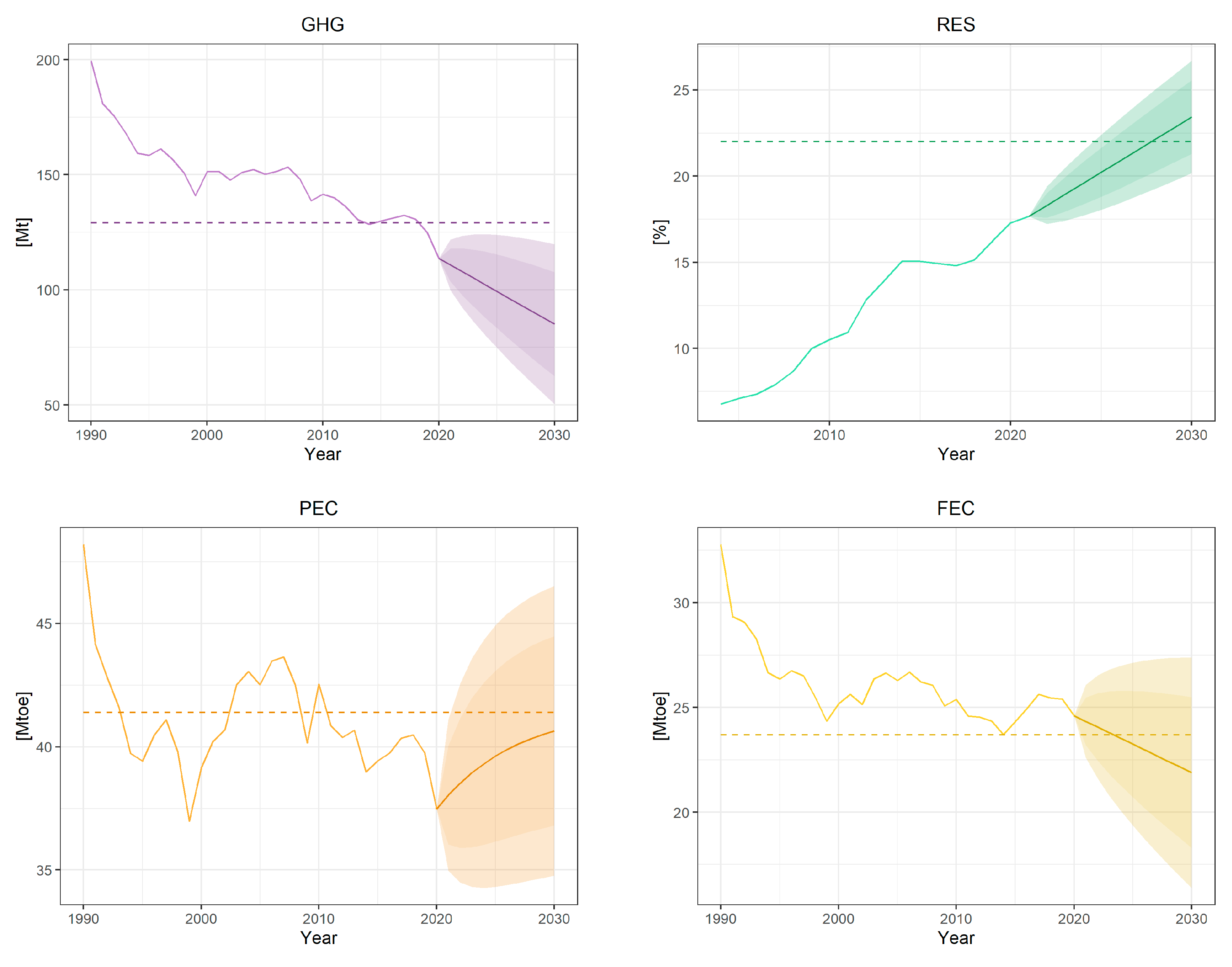
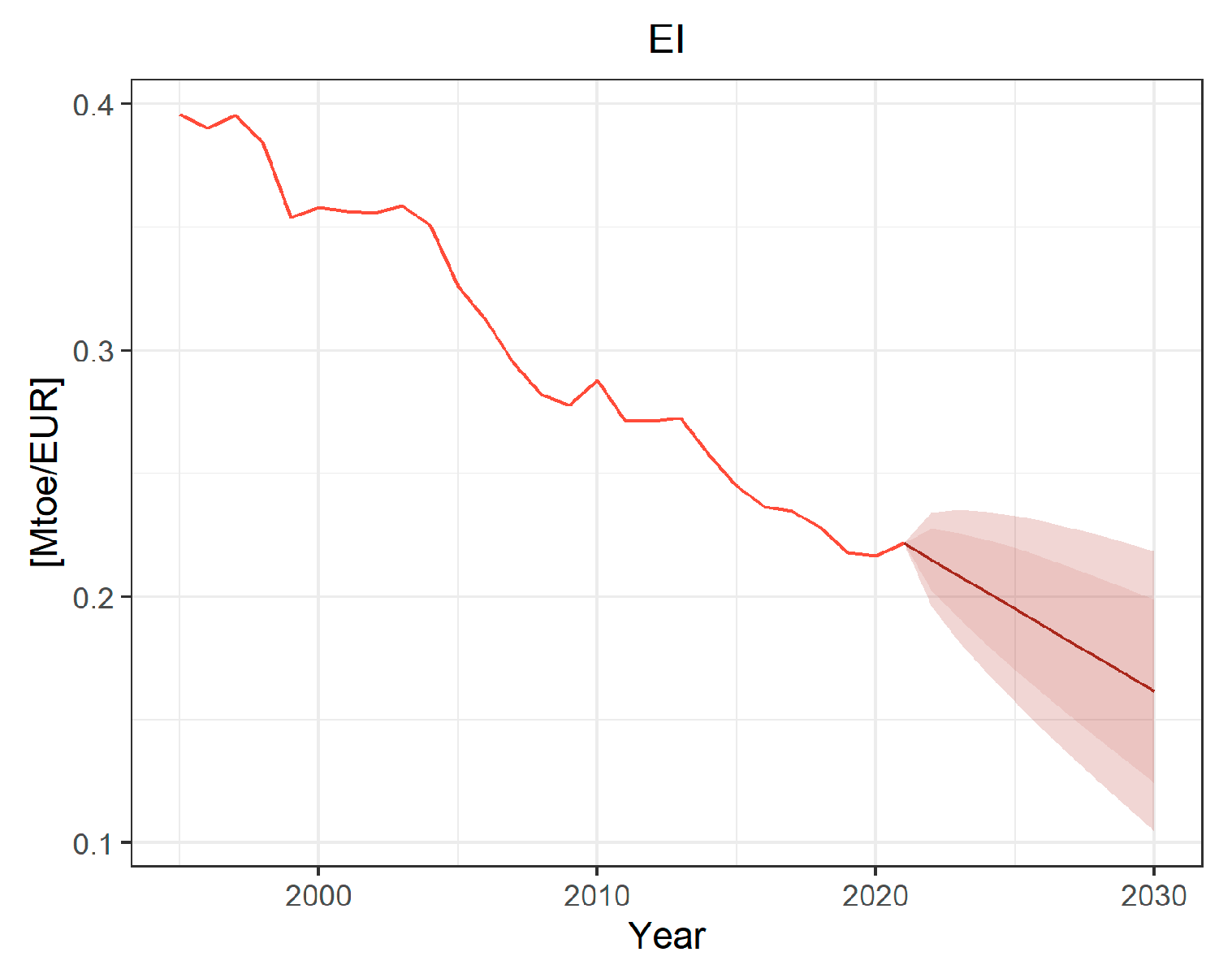
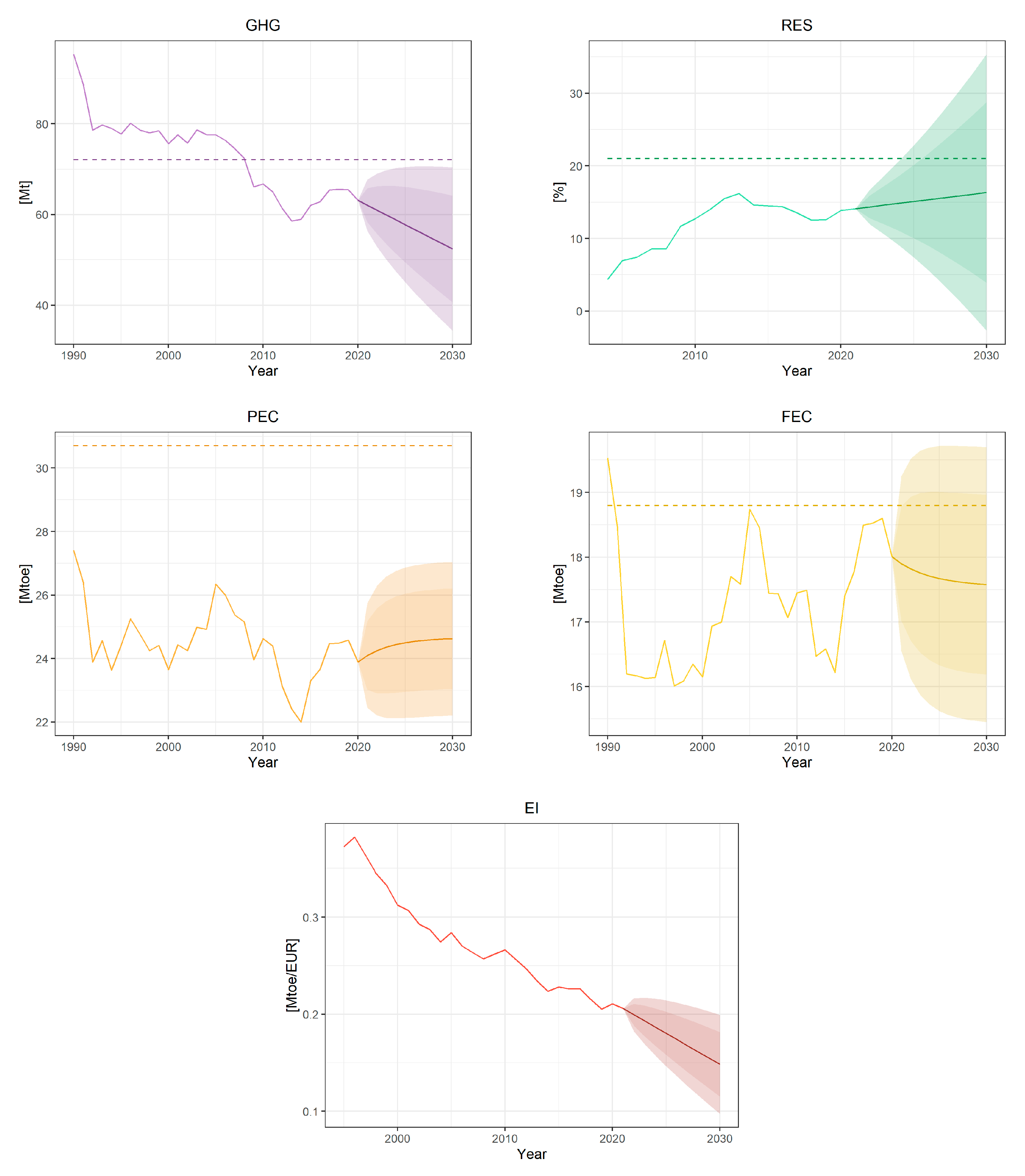

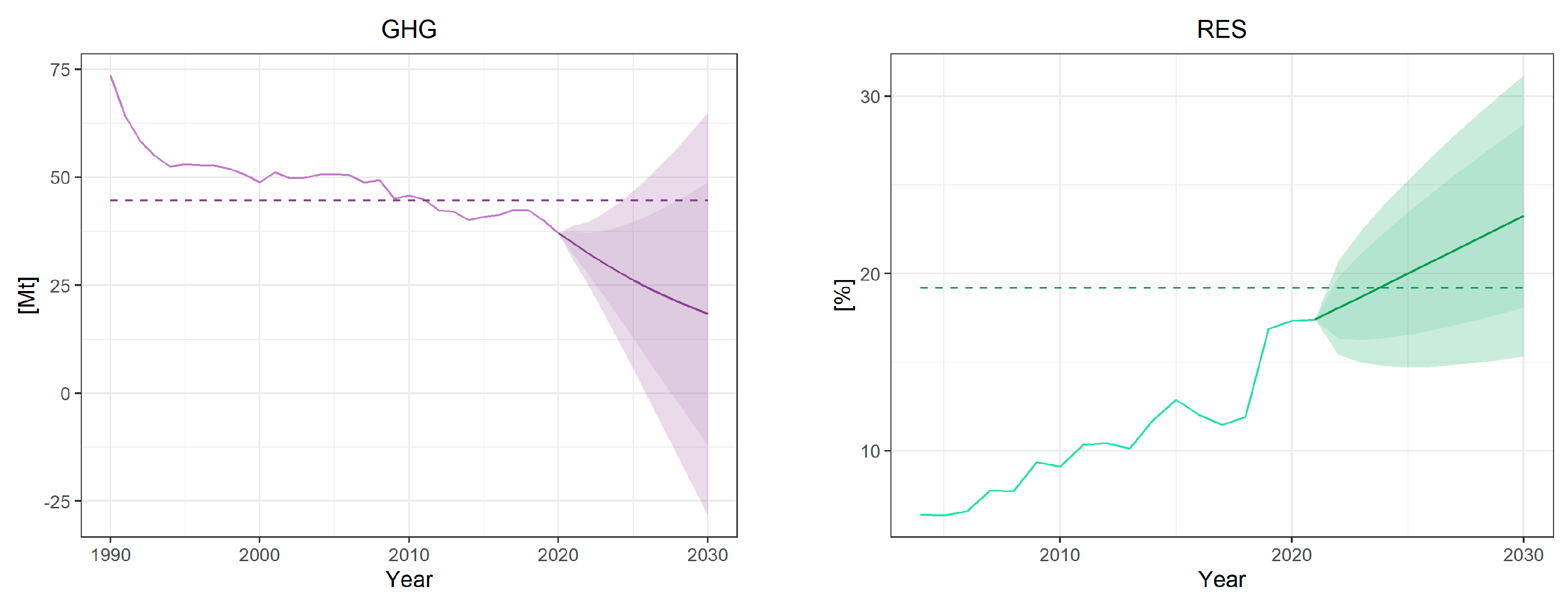
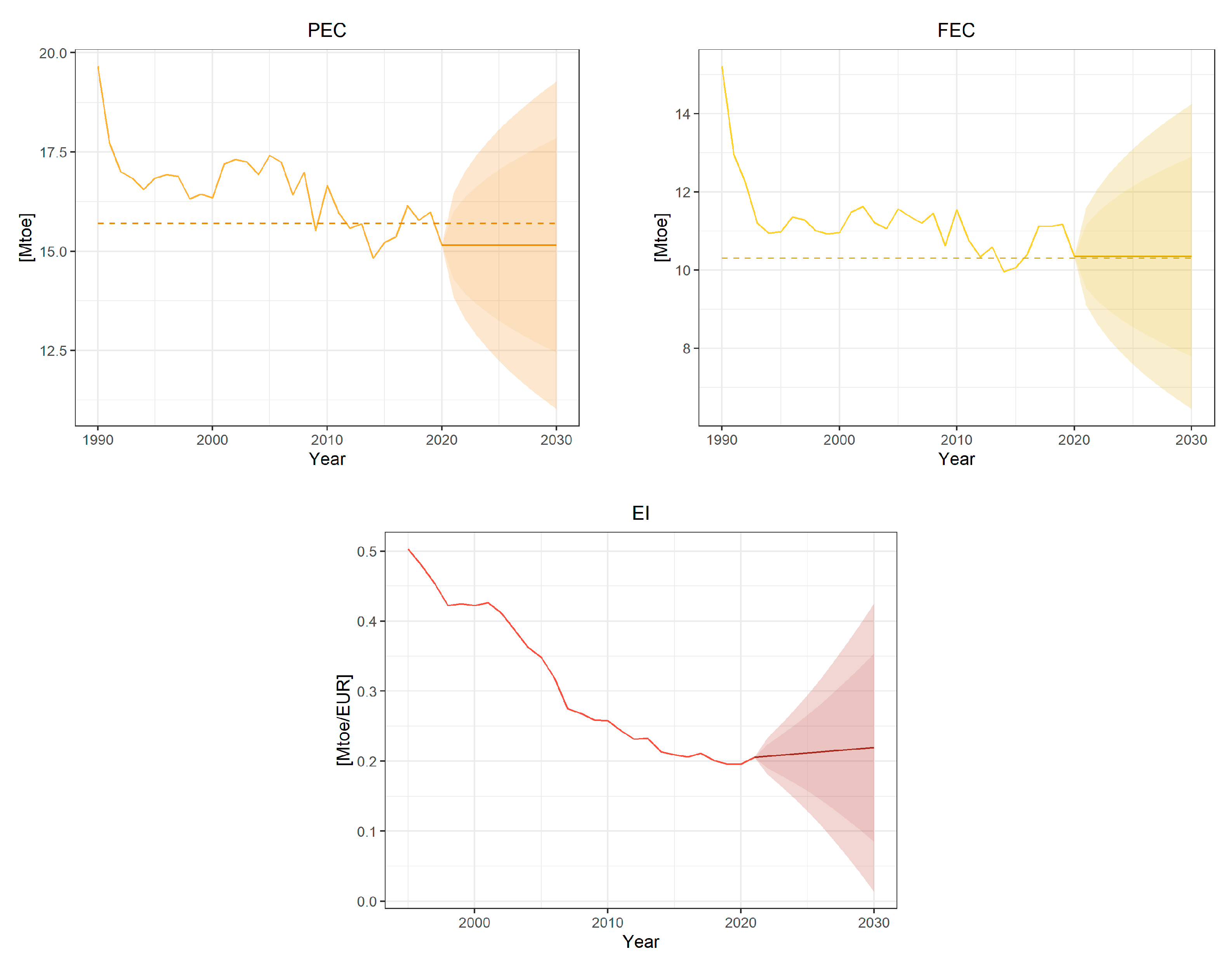
| EU Member State | Greenhouse Gas Emissions [Mt] | Share of Renewable Energy *1 [%] | Primary Energy Consumption [Mtoe] | Final Energy Consumption [Mtoe] |
|---|---|---|---|---|
| Czech Republic | 163.7 | 13 | 39.6 | 25.3 |
| Hungary | 85.3 | 13 | 24.1 | 14.4 |
| Poland | 463.0 | 15 | 96.4 | 71.6 |
| Slovakia | 57.3 | 14 | 16.4 | 9.0 |
| EU | 3706 | 20 | 1483.0 | 1086.0 |
| EU Member State | Greenhouse Gas Emissions [Mt] | Share of Renewable Energy *1 [%] | Primary Energy Consumption [Mtoe] | Final Energy Consumption [Mtoe] |
|---|---|---|---|---|
| Czech Republic | 129.2 | 22 | 41.4 | 23.7 |
| Hungary | 72.1 | 21 | 30.7 | 18.8 |
| Poland | 378.0 | 21 *2 | 91.3 | 67.1 |
| Slovakia | 44.6 *3 | 19.2 | 15.7 | 10.3 |
| EU | 2084.8 | 32 | 1176.0 | 885.0 |
| Fuel | Czech Republic [%] | Hungary [%] | Poland [%] | Slovakia [%] | EU27 [%] |
|---|---|---|---|---|---|
| Heat | 0.0 | 0.0 | 0.1 | 0.0 | 0.0 |
| Natural Gas | 0.7 | 11.1 | 5.6 | 0.7 | 0.7 |
| Nonrenewable Waste | 1.5 | 1.3 | 1.6 | 3.2 | 1.5 |
| Nuclear Heat | 31.4 | 37.9 | 0.0 | 58.3 | 31.4 |
| Oil and Petroleum Products | 0.4 | 10.2 | 1.5 | 0.1 | 0.4 |
| Oil Shale and Oil Sands | 0.0 | 0.0 | 0.0 | 0.0 | 0.0 |
| Peat and Peat Products | 0.0 | 0.0 | 0.0 | 0.0 | 0.0 |
| Renewables and Biofuels | 23.1 | 32.2 | 21.3 | 33.8 | 23.1 |
| Solid Fossil Fuels | 43.0 | 7.3 | 69.9 | 3.9 | 43.0 |
| EU Member State | Solid Fossil Fuels, Oil, and Petroleum Products in Primary Energy Production [%] | Renewables and Biofuels in Primary Energy Production [%] |
|---|---|---|
| Czech Republic | 43.4 | 23.1 |
| Hungary | 17.5 | 32.2 |
| Poland | 71.4 | 21.3 |
| Slovakia | 4.0 | 33.8 |
| EU | 18.4 | 40.9 |
Disclaimer/Publisher’s Note: The statements, opinions and data contained in all publications are solely those of the individual author(s) and contributor(s) and not of MDPI and/or the editor(s). MDPI and/or the editor(s) disclaim responsibility for any injury to people or property resulting from any ideas, methods, instructions or products referred to in the content. |
© 2023 by the authors. Licensee MDPI, Basel, Switzerland. This article is an open access article distributed under the terms and conditions of the Creative Commons Attribution (CC BY) license (https://creativecommons.org/licenses/by/4.0/).
Share and Cite
Brożyna, J.; Strielkowski, W.; Zpěvák, A. Evaluating the Chances of Implementing the “Fit for 55” Green Transition Package in the V4 Countries. Energies 2023, 16, 2764. https://doi.org/10.3390/en16062764
Brożyna J, Strielkowski W, Zpěvák A. Evaluating the Chances of Implementing the “Fit for 55” Green Transition Package in the V4 Countries. Energies. 2023; 16(6):2764. https://doi.org/10.3390/en16062764
Chicago/Turabian StyleBrożyna, Jacek, Wadim Strielkowski, and Aleš Zpěvák. 2023. "Evaluating the Chances of Implementing the “Fit for 55” Green Transition Package in the V4 Countries" Energies 16, no. 6: 2764. https://doi.org/10.3390/en16062764
APA StyleBrożyna, J., Strielkowski, W., & Zpěvák, A. (2023). Evaluating the Chances of Implementing the “Fit for 55” Green Transition Package in the V4 Countries. Energies, 16(6), 2764. https://doi.org/10.3390/en16062764








